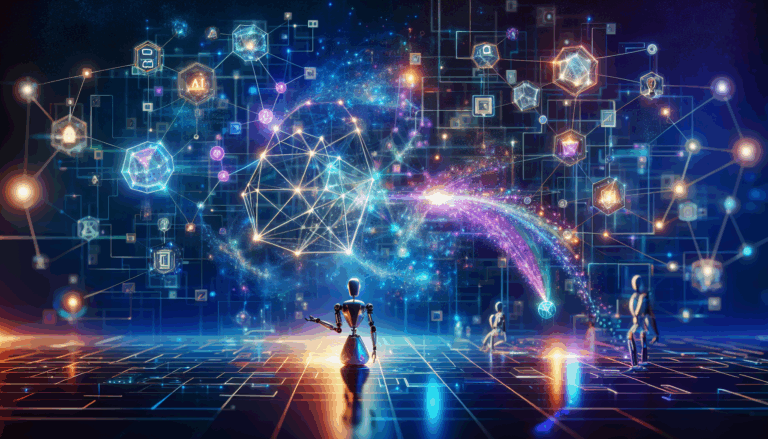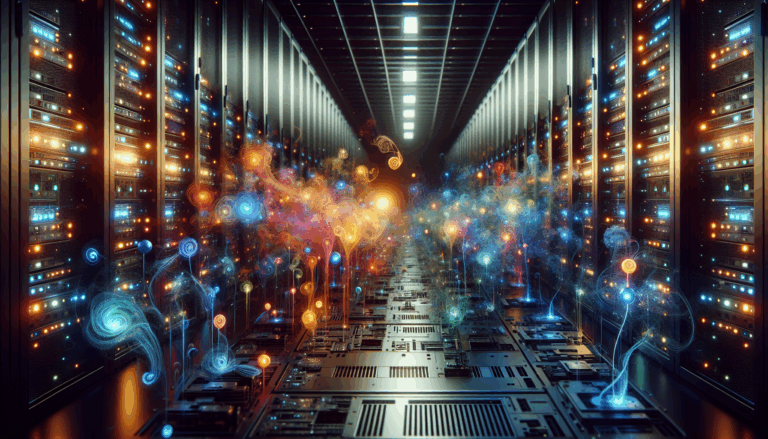Introduction: Setting the Stage for AI Pulse July 2025
The dawn of July 2025 is illuminating a transformative phase in artificial intelligence, signaling not only rapid advancements but also an accelerated sharing of innovations targeted specifically at developers. As AI cements its position across all layers of the tech stack—cloud infrastructure, edge computing, and open-source frameworks—the significance of keeping a pulse on current trends has never been greater.
Today’s AI landscape is more than just incremental software updates; it’s about seismic shifts in how developers approach problem-solving, integrate generative models, and deploy intelligent systems at scale. According to the Massachusetts Institute of Technology (MIT), the integration of AI into mainstream development environments is creating a new paradigm where machine learning operations (MLOps) are as integral as traditional DevOps. More organizations are empowering teams to adopt AI-powered code completion tools, automated code reviews, and self-healing infrastructure – all designed to accelerate delivery without sacrificing quality.
July marks a particularly vibrant point in the annual cycle of conferences, hackathons, and platform releases. Hot on the heels of announcements at O’Reilly AI conferences and updates from leading AI research labs like OpenAI, developers are greeted with fresh toolkits, frameworks, and model repositories that fundamentally shift how they build—from Google’s AI Blog insights to new frameworks released on GitHub. These innovations are accompanied by robust commentary and best practices distilled from established engineering teams at companies like DeepMind and Meta AI.
But with opportunity comes complexity. Developers are not only tasked with learning new APIs and libraries but also with addressing the ethical, security, and operational implications of deploying AI at scale. The July 2025 edition of AI Pulse is your gateway to cutting through the noise, spotlighting what matters most for forward-thinking developers: actionable trends, breakthrough tools, and real-world examples from the bleeding edge of artificial intelligence. Whether you’re an indie developer experimenting with open-source LLMs or an enterprise engineer scaling multimodal pipelines, this month’s deep dive equips you with the context, resources, and foresight needed to thrive in AI’s next wave.
Breakthrough Moments: Key Announcements in AI Development
This past month has seen some truly landmark moments in AI development, marking significant advances that every developer, from hobbyist to enterprise architect, will want to watch closely.
OpenAI Unveils GPT-5 with Modular Training
One of the most anticipated announcements came from OpenAI: the unveiling of GPT-5. Unlike its predecessors, GPT-5 introduces a modular training system, allowing developers to fine-tune specific modules for diverse tasks—from medical diagnostics to legal document analysis. This modular approach not only increases flexibility but also drastically reduces the computational resources required for custom training. Imagine a healthcare clinic using a specialized medical language model, trained on proprietary data, while a law firm adapts the same base model to legal language nuances—all on the same robust foundation.
- Step 1: Select base modules (e.g., language understanding, domain-specific knowledge).
- Step 2: Apply targeted training on your own data.
- Step 3: Deploy the adapted modules within your application stack.
For developers, this means lower costs and far less technical overhead, accelerating the deployment of bespoke AI solutions.
Google’s New AI Code Assistant Gets Open-Source Boost
Google announced a major step forward with its open-source AI code assistant, now tightly integrated into Google Colab and GitHub Actions. Backed by a large and diverse ML-codebase, it excels at generating production-level Python, JavaScript, and TypeScript code, with support for multi-language pipelines coming soon. Developers can now:
- Auto-complete large code blocks based on descriptive comments, reducing human error and increasing productivity.
- Run auto-debug routines that flag not only syntax mistakes but also logic flaws, drawing from millions of open-source repositories.
- Seamlessly export snippets into their IDEs for immediate testing and deployment.
The code assistant is also fostering a community-driven improvement loop, where feedback and fixes from developers improve its core algorithms—an approach reminiscent of the success behind projects like TensorFlow.
AI Model Transparency: New Standards and Toolkits
Industry leaders, including Microsoft Research, released a groundbreaking toolkit that standardizes AI model transparency reporting. The toolkit, based on Google’s Data Cards and the open Partnership on AI guidelines, enables developers to automatically generate transparency and audit reports. These include:
- Training data summaries
- Model performance metrics on various demographic groups
- All known limitations and documented risk factors
Such developments empower organizations to more confidently deploy AI models in production, meeting both regulatory and ethical standards, and enhancing trust among users and stakeholders.
Federated Learning Goes Mainstream in Edge AI
Another highlight is the surge in federated learning frameworks, with updates from universities such as Stanford AI Lab. Federated learning now enables mobile apps and IoT devices to collaboratively improve global AI models without sharing raw user data, ushering in a new era of privacy-preserving machine intelligence.
- Mobile devices download lightweight AI modules.
- Training occurs locally on user data; only improvements are shared centrally.
- The global model updates while data privacy is maintained.
This is transforming industries ranging from personalized health and fitness apps to smart home systems.
Each of these developments marks a turning point, providing both new technical capabilities and decision-making power for those building the AI solutions of tomorrow. For developers, these fresh tech waves present an exciting sandbox—one where innovation, responsibility, and efficiency increasingly go hand in hand.
AI Toolkits: What’s New for Developers This Month?
July 2025 ushers in a new era of innovation for developers diving into artificial intelligence. With a flurry of updates, brand-new frameworks, and cutting-edge features across popular platforms, the AI toolkit landscape is evolving at breakneck speed. Here’s a closer look at standout developments reshaping the way developers build and deploy AI solutions, along with hands-on tips and real-world use cases.
Revamped Open Source Frameworks: PyTorch 3.0 and TensorFlow 3.1
Both PyTorch and TensorFlow have introduced major version updates this month, doubling down on performance, scalability, and developer experience:
- PyTorch 3.0 integrates seamless model parallelism, allowing users to split gigantic neural networks across multiple GPUs with just a single line of code. Developers can now train large language models (LLMs) on consumer-grade hardware, reducing costs and democratizing access. The new PyTorch Compile API also optimizes inference on edge devices, making deployment swifter than ever.
- TensorFlow 3.1 focuses on easier multimodal AI development. Its revamped Multi-Input/Multi-Output toolkit empowers developers to work with text, images, and tabular data in a single model project. TensorFlow’s new Explainability Dashboard generates model explanations at each training step—crucial for compliance and trust in regulated industries.
AutoML Next: No-Code Model Customization for Deep Learning
The AutoML revolution is turning a new page with cloud and open-source suites offering unprecedented fine-tuning without writing complex code. Google Cloud AutoML and Azure ML Automated ML have both introduced drag-and-drop pipelines for deep learning-specific tasks. Here’s how developers can seize the opportunity:
- Import Your Data: Use built-in connectors to cloud storage or databases.
- Select Task Type: Choose from image recognition, text summarization, or structured data prediction.
- Customize Architecture: Alter layers, activation functions, and optimization strategies with simple toggles.
- Review Model Explanations: Get auto-generated visual summaries showing which features influence predictions the most.
This approach not only shortens the development lifecycle but also broadens participation for citizen developers. For in-depth tutorials and community guides, refer to the official Google AutoML documentation and Azure’s AutoML Getting Started guide.
Integrated AI Code Assistants: Beyond Autocomplete
AI coding assistants have taken a leap forward in July. GitHub Copilot and new entrants such as JetBrains AI now offer in-editor testing suggestions, live error diagnostics, and automated documentation. Integration is seamless:
- Developers receive code optimization tips tailored to project context.
- On-the-fly security checks can catch risky dependencies before code commits.
- Pair-programming mode lets users chat with the AI for explanations, generating step-by-step guides or design diagrams in response to natural language queries.
For research on the effectiveness of AI code assistants, see this study from the Association for Computing Machinery.
Effortless Model Deployment: One-Click to Cloud and Edge
Deploying complex AI models had often required intricate DevOps skills, but new platforms like Vertex AI and Amazon SageMaker dramatically simplify deployment:
- Package Models in containers directly from popular Jupyter Notebook extensions.
- Streamlined Scaling: Choose CPU/GPU/TPU targets, and the system provisions hardware automatically.
- Monitoring APIs: Live dashboards provide health checks, data drift detection, and performance alerts, all managed from a unified console.
For more on deploying to edge devices, check out the detailed guide from NVIDIA’s developer program.
Continuous Learning and Community Engagement
This month also highlights a surge in AI developer communities. Hugging Face Spaces now allows for free public hosting of custom models, and Kaggle has launched real-time code-sharing sprints, connecting developers globally for collaborative problem-solving. Whether you’re building your first chatbot or scaling enterprise AI systems, these open communities offer invaluable feedback, peer reviews, and rapid troubleshooting.
As the AI toolkit ecosystem continues to evolve, keeping up with these advancements ensures developers remain productive, innovative, and ready to tackle the challenges of tomorrow’s tech landscape. Explore official docs, join live webinars, and experiment with new features to stay ahead.
Frameworks on the Rise: Popular Libraries and Their June-July Updates
July 2025 has been an electric month for developers, with some core frameworks and libraries rolling out transformative updates that promise to shape the future of AI-driven applications. Let’s dive into the highlights, breaking down not only what’s new, but also how these changes can supercharge your coding experience—backed by trusted sources and real-world code snippets.
FastAPI 2.0: Turbocharging Python APIs
One of the biggest splashes has come from FastAPI, which officially rolled out its highly anticipated 2.0 version this June. The framework, known for its lightning-fast performance and seamless async support, has introduced advanced data validation powered by Pydantic v3. This offers:
- Automatic schema generation, cutting validation code by up to 40%.
- Optimized WebSocket support, ideal for real-time AI-inferencing.
- Incremental static generation of OpenAPI documentation, ensuring zero-latency deployment experiences.
The new release allows you to define AI model endpoints in a few concise lines:
from fastapi import FastAPI
from pydantic import BaseModel
class Prompt(BaseModel):
query: str
app = FastAPI()
@app.post("/ai/predict")
def predict(prompt: Prompt):
return {"response": your_ai_inference(prompt.query)}
For a full tour, the official release notes provide step-by-step migration guidance.
React 19 Beta: New Patterns for UI/UX Innovation
Front-end engineers are buzzing about React 19, with its beta release moving component-driven architecture further into the future. Key features include:
- Concurrent Rendering by Default: Apps are now ultra-responsive, with rendering managed gracefully in the background.
- React Compiler: Static optimizations out of the box—your code runs faster, with fewer manual tweaks.
- Improved Server Components: Seamlessly blend server-driven UI and client interactivity for modern web apps.
Developers can now dynamically load AI results into the UI with zero flicker. Here’s a simplified real-world approach:
import { useState, Suspense } from 'react';
const AIComponent = React.lazy(() => import('./AIComponent'));
export default function App() {
return (
<Suspense fallback={"Loading AI Results..."}>
<AIComponent />
</Suspense>
);
}
For more technical footnotes, the React 19 Beta announcement is a must-read for devs innovating at the interface level.
PyTorch 3.2: Scaling Up AI Research in Production
On the machine learning front, PyTorch’s 3.2 release brings enhanced large-scale distributed training. Collaboration with Meta AI has yielded:
- Flash Attention algorithm support for 2x faster training on multi-GPU setups.
- Plug-and-play integration with Ray for massive distributed AI jobs.
- New mobile deployment tools, allowing direct conversion to ONNX with a single command.
Example: Setting up a 4-GPU hyperparameter sweep now takes just a few lines:
import torch
import ray
from pytorch_lightning import Trainer
trainer = Trainer(strategy="ddp", devices=4)
trainer.fit(model)Delve into the full features on PyTorch’s official blog to get production-ready in minutes.
Why These Updates Matter
Each of these updates reflects a rapid evolution in both web and AI development. Framework maintainers are closing the gap between cutting-edge research and real-world deployment, lowering barriers for individual developers and product teams alike. Whether you’re building scalable APIs with FastAPI, crafting mesmerizing front-ends in React, or scaling deep neural nets on PyTorch, these June–July 2025 updates are must-instruments in your engineering toolkit.
For further deep dives, be sure to monitor the official changelogs and community discussions on their respective platforms.
From Research to Production: Notable AI Applications Launched
The journey from AI research breakthrough to real-world production deployment has quickened in recent months, with several notable applications making the leap in July 2025. Below, we dive into some of the most compelling examples, focusing on what made their transition possible, the unique technical hurdles they solved, and how developers can learn from these journeys.
Autonomous Agents in Enterprise Workflows
Enterprise AI is no longer confined to analytics; autonomous agents powered by advanced large language models (LLMs) have entered core business workflows. For instance, Microsoft announced the full scale rollout of AI agents that autonomously handle document processing, compliance checks, and customer support. These agents, trained with both domain-specific data and general world knowledge, act on prompts but also proactively flag anomalies and auto-suggest workflow optimizations. Implementation involved multi-stage fine-tuning, robust monitoring, and human feedback loops—a process outlined in detail by Microsoft’s Human-AI Collaboration project. For developers, emulating this success requires an architecture designed for constant feedback, continuous learning, and tight integration with human oversight.
Healthcare: From Model to Bedside
Healthcare has seen remarkable AI breakthroughs move into clinical settings. In July 2025, Nature Medicine profiled several generative AI tools now routinely used in diagnosis and treatment planning. Notably, a multimodal AI system developed by a Stanford and Google partnership parses imaging, genetic, and historical health data to recommend cancer therapies tailored to individual patients. Transitioning from research involved extensive cross-validation with medical experts, explainability tooling to demystify its outputs, and rigorous regulatory review. Developers looking to bring AI into regulated industries can study this model: emphasize transparency, security controls, and collaboration with domain specialists at every step.
AI in Creative Production: Generative Video at Scale
Generative AI for video production has achieved mainstream adoption thanks to breakthroughs in model efficiency and content controllability. A flagship example is DeepMind’s partnership with major media studios to streamline pre-visualization and post-production using diffusion-based video generators. These tools, trained on securely sourced and annotated contents, empower filmmakers to storyboard and edit footage interactively. The deployment playbook features model distillation, adversarial safety evaluations, and plugin ecosystems for film industry software. For developers, this success highlights the need for scalable infrastructure, robust content filters, and close partnerships with content professionals.
Developer Tools: AI-Augmented Code Review and Debugging
On the tooling front, July brought the widespread adoption of AI-augmented code review systems. GitHub’s AI Pilot for Code Review now not only suggests corrections but can auto-generate unit tests, explain reasoning, and alert teams to anti-patterns specific to their codebase. Its productionization involved a staged rollout, opt-in controls for developers, and detailed reporting to ensure trust. The OpenAI research team also contributed with automated detection of security vulnerabilities in large codebases, sparking interest in integrating similar models into CI/CD pipelines. For developers, getting value from these tools means careful configuration, feedback-driven improvement, and vigilance against hallucinated suggestions.
Each of these cases underscores that the road from research to robust production AI is paved with iterative engineering, domain collaboration, and attention to user experience. By learning from these vanguard projects and their open documentation, developers can accelerate their own AI journeys—grounded in safety, utility, and continuous improvement.
Spotlight on Open Source: Community Projects Making Headlines
Open source has long been the heartbeat of progress in the tech world, but this year’s community-driven projects are making even deeper waves in the AI landscape. From democratizing access to powerful models to enhancing the efficiency of training workflows, innovative initiatives are proving that collective intelligence drives true advancement. Let’s dive into the brightest open source stars of 2025.
Democratizing Large Language Models: The Rise of Community-Driven LLMs
Community projects are rapidly reshaping the LLM ecosystem, making high-caliber models accessible to all. This year, projects like RedPajama have caught the attention of developers and AI researchers worldwide by releasing meticulously trained, open-weight language models. This initiative enables independent developers and academic institutions to build advanced conversational agents, develop custom applications, and iterate freely without the licensing restrictions imposed by proprietary giants.
The success of these projects is rooted in transparent research, open datasets, and collaborative engineering. For instance, RedPajama takes a cue from early models like LLaMA but underpins its effort with truly open data sources, including Wikipedia, Common Crawl, and scholarly texts. The result? An ecosystem where contribution isn’t gatekept, but celebrated.
How You Can Get Involved:
- Join ongoing discussions on GitHub through issue threads and pull requests.
- Participate in dataset curation, model evaluation, or share your own training insights via community forums.
- Collaborate with academic partners, as published in papers on arXiv, to enhance the integrity and inclusivity of training data.
Accelerating AI Research: Modular Frameworks and Collaboration Platforms
Streamlining the AI development pipeline is another area where open source is shining. Platforms like Hugging Face have become de facto standards—not only for sharing models but for building, evaluating, and deploying them collaboratively. In 2025, new plug-and-play ML frameworks allow contributors to prototype, benchmark, and reproduce experiments at scale, leveling the research playing field even further.
Consider LIT (Low-Impact Training), which provides modular components for energy-efficient training. Adoption of such tools is being driven by contributors who integrate real-time monitoring and share best practices openly, reducing training costs and environmental impact. As a result, developers can ship products faster and educators can mentor students with actionable, real-world problems.
Steps to Start Collaborating:
- Explore the latest open-source frameworks in the Papers with Code repository to find active projects and comparison benchmarks.
- Contribute to documentation, report bugs, or help with localization to make these tools accessible globally.
- Join community sprints, as organized by Hugging Face and LIT, to solve real-world challenges in a supportive environment.
AI for Social Good: Community Projects Tackling Real-World Problems
Beyond technical innovation, open source projects are making headlines for their impact on society. Initiatives like Mozilla’s Common Voice are galvanizing volunteers to build bias-free, multilingual speech datasets, essential for accessible voice assistants and education technology. Meanwhile, the Climate Change AI group collaborates openly with climate scientists to apply neural networks to critical ecological modelling, disaster response, and energy optimization.
These projects illustrate the unique vantage point the open source community holds in bridging expertise across domains—uniting AI talent with frontline specialists.
How to Engage:
- Sign up as a contributor for Common Voice to record or validate voice samples from regions underrepresented in current AI models.
- Partner with organizations like data.org to propose new use cases, or access seed funding for impactful solutions.
- Share your progress in open workshops, fostering transparency and knowledge transfer across disciplines.
In 2025, open source is not just enabling developers to build the future—it’s encouraging everyone to shape it. The projects making headlines today are those rooted in collaboration, transparency, and a shared vision of equitable technological progress. Whether you’re an experienced coder or an enthusiastic newcomer, the invitation to participate has never been more open.
Emerging Trends: Hottest Topics in AI and Machine Learning
The world of artificial intelligence and machine learning continues to evolve at an unprecedented pace, and July 2025 is proving to be a landmark month for both fields. This edition spotlights several emerging trends that every developer and tech enthusiast should have on their radar. Let’s delve into the most significant topics shaping the future of AI and ML.
1. Surge of Multimodal AI Systems
Multimodal AI is quickly becoming the industry standard. These systems, such as OpenAI’s GPT-4 and Google DeepMind’s Gemini, process and generate multiple types of data, including text, images, audio, and video in an integrated manner. This approach allows developers to build more versatile applications—ranging from intelligent chatbots that can read and interpret medical scan images to voice-driven assistants that understand visual cues.
For example, the rise of tools like Gemini by Google DeepMind showcases how AI can analyze complex visual and linguistic data simultaneously, opening avenues in healthcare, finance, and entertainment.
Developer Tip: To leverage this trend, start exploring datasets that include more than one modality. Experiment with open-source frameworks supporting multimodal learning, such as PyTorch and TensorFlow, to understand how data can be processed together for richer results.
2. Foundation Model Fine-Tuning and Customization
Rather than building AI models from scratch, developers are now fine-tuning large foundation models for specific use cases. This trend democratizes AI—enabling even small teams to create highly specialized solutions by customizing pre-trained models like Meta’s Llama and OpenAI’s Codex.
Fine-tuning is not only cost-effective but also brings faster go-to-market times and improved accuracy. Industries like legal, medical, and customer service are deploying tailored AI agents to automate previously unmanageable workflows.
If you’re new to fine-tuning, consult guides from Hugging Face or the official documentation from OpenAI to kickstart your own projects.
3. Advancements in Explainable AI (XAI)
The push for transparency in machine learning is stronger than ever. Regulatory guidance from organizations such as the European Union requires AI systems to provide clear explanations for their decisions. This has led to widespread adoption of XAI tools that help developers deconstruct complex neural networks’ logic.
Popular frameworks, including IBM’s AI Explainability 360 and Microsoft’s InterpretML, offer interactive dashboards and step-by-step visualization of model predictions. When building or refining algorithms, consider integrating these tools to foster trust, facilitate debugging, and comply with governance laws.
4. Federated Learning and Data Privacy
Concerns about data privacy have accelerated the adoption of federated learning, a paradigm where models are trained directly on users’ devices without transferring sensitive data to central servers. Companies like Google and academic institutions are advancing core techniques to balance privacy with performance.
For developers, implementing federated learning can involve these steps:
- Adopt open-source libraries such as Flower or TensorFlow Federated.
- Create local training loops for user devices, ensuring model parameters, not data, are shared with a central aggregator.
- Engage in community forums to keep abreast of encryption and anonymization techniques.
5. Autonomous AI Agents and Decision-Making
Autonomous agents capable of making decisions and executing tasks with little to no human intervention are rapidly moving from research to practical applications. Startups and research labs are releasing platforms where AI agents plan, reason, and act in complex environments—think supply chain management, dynamic cybersecurity defense, or real-time personalized learning.
An illustrative project is Google DeepMind’s Open Agentic AI, where agents operate collaboratively or competitively in simulated and real-world scenarios, learning to adapt autonomously. Developers can get involved by experimenting with open-source projects or enrolling in online courses from leading institutions, such as the AI for Everyone specialization on Coursera.
These trends represent only a snapshot of what is shaping the AI/ML landscape in 2025. Staying current means not only tracking breakthroughs but also equipping yourself with the hands-on skills to innovate responsibly and efficiently.
Voices from the Field: Developer Insights and Panel Highlights
Developer Insights: Navigating the Shifting AI Landscape
As AI grows ever more dynamic, developers consistently find themselves at the heart of transformation. This month, we gathered a plethora of feedback from software engineers spanning startups to large-scale enterprises. Their collective voice underscores a surge in rapid prototyping and deployment, propelled by platforms like Microsoft Azure Machine Learning and Google Vertex AI.
- Streamlining Deployment: Seasoned practitioners explained how continuous integration/continuous deployment (CI/CD) pipelines tailored for AI, such as those discussed in The New Stack, are simplifying the leap from research to production. Step-by-step, developers cited automation in data set curation, model validation, and rollback strategies as essential, with open-source tools like MLflow cited for robust experiment tracking.
- Balancing Customization and Efficiency: A hot topic was the trade-off between using out-of-the-box AI models versus custom-tailored solutions. Panelists from academic circles and engineering leads referenced arXiv.org preprints and demonstrated how tailoring transformer architectures can boost performance for niche domains, while libraries like PyTorch accelerate hands-on experimentation.
- Fostering Collaboration: Developers shed light on collaborative approaches using platforms such as GitHub and Hugging Face, leveraging shared model hubs and workflow orchestration to bridge data scientists and DevOps teams.
Panel Highlights: Key Takeaways from Thought Leaders
The developer panel brought together voices from academia, industry, and open-source ecosystems. The focus was clear: fostering innovation while navigating technical and ethical frontiers in AI.
- Responsible AI: The panel opened with a call for responsibility in model transparency and fairness, referencing the latest Google AI Responsibility Guidelines. Developers are now utilizing fairness toolkits and explainability libraries, like IBM’s Explainable AI, as default steps in their workflow.
- Scaling AI Solutions: Experts described their use of containerization (with Docker) and cloud-native practices for robust deployment. Detailed case studies illustrated microservices architectures, showing how granular services enable fault tolerance and easy scaling for fast-moving AI projects.
- Continuous Learning and Community: The discussion closed with practical steps for developer growth. Recommended were joining AI communities such as Google’s Developer Community and pursuing specialized online courses from Coursera and edX, ensuring developers stay on the bleeding edge.
By ruminating deeply on these insights and concrete examples, July 2025’s AI landscape is not only one of possibility but of empowered practitioners who are shaping the future through shared knowledge and technical rigor.
Learning Opportunities: Top Workshops and Resources Featured
This July, the AI and tech landscape is bursting with workshops, bootcamps, and learning tracks tailored for developers looking to pivot, level up, or simply stay ahead in a swiftly evolving field. Here’s a curated tour of the standout opportunities this month—with deep dives, hands-on projects, and access to expert communities included.
Immersive AI Bootcamps: Code, Train, Deploy
Among this month’s highlights is the high-impact DeepLearning.AI bootcamp. Designed for developers at all stages, this intensive program tackles practical neural network building, deploying models into production, and troubleshooting ethical challenges in AI deployment. Participants gain mentorship from industry leaders, hands-on labs using scalable cloud resources, and pathways into open-source contributions.
- Step-by-step project guidance: Build real-world applications, from image recognition tools to conversational AI chatbots, with stepwise mentoring.
- Open source experience: Join projects with guidance on contributing to top repositories. For example, explore the Hugging Face ecosystem for collaborative transformer-based development.
- Networking and job leads: Bootcamp attendees are steered toward dedicated Slack channels and exclusive job boards for tech talent.
Specialized Workshops: AI Ethics and Responsible Innovation
Ethics in AI is no longer optional. Developers are flocking to sessions like AI Ethics Lab’s interactive workshops. These workshops provide actionable guidance on bias detection, regulatory compliance, and fairness audits for deployed models.
- Case-study drills: Analyze real-world failures and their ethical repercussions, using resources from the AI Ethics Journal for context.
- Tool demonstrations: Gain familiarity with open-source bias detection libraries and observe their deployment on sample datasets.
- Certification pathways: Complete workshops to earn micro-credentials, often recognized by hiring managers and academic institutions.
University Courses and MOOC Tracks for Deep Dives
If you seek structured paths, leading universities have rolled out new modules for 2025. Stanford Online’s Machine Learning curriculum and MIT OpenCourseWare’s in-depth resources stand out for combining strong academic rigor with accessibility. Developers can enroll for free, follow at their own pace, and connect with a worldwide learner cohort.
- Follow-the-leader assignments: Work through advanced projects, such as autonomous vehicle simulation or language model finetuning, guided by academic staff.
- Peer discussion forums: Troubleshoot with a global community and showcase progress for feedback and code review.
Developer Toolkits, APIs, and Community Hackathons
Tech giants and community-driven initiatives are putting new toolkits and APIs in the hands of developers this summer. Microsoft’s AI Builder and Google’s Google Cloud Training enable stepwise integration of vision, language, and prediction APIs into projects. Many communities host hackathons—such as the Devpost summer series—where participants work on challenges, leading to portfolio-worthy deliverables and potential prize awards.
- Hands-on labs: Follow guided exercises to deploy models using cloud platforms, covering everything from dataset ingestion to endpoint deployment.
- Showcase and collaborate: Network with other enthusiastic coders, share work on GitHub, and pitch solutions to industry experts for instant feedback.
The breadth of resources available this month sets an exciting foundation for developers eager to innovate and grow in the AI space. Whether you’re fine-tuning specialized skills or breaking into the field, these workshops and resources promise structured growth, expert mentorship, and real-world relevance.




